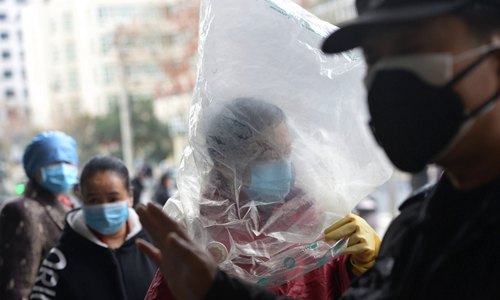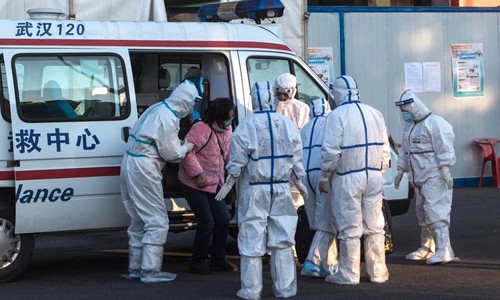The number of new corona virus cases soared after China changed its calculation, raising questions about the peak period.
Health officials in Hubei Province since February 13, have applied the new method of statistics of new cases of coronavirus, making the number of people infected each day increase many times higher than before. This led epidemiologists, Chinese officials and even investors to rethink their predictions about the progress of the Covid-19 epidemic.

A woman uses a plastic bag to cover her head to avoid spreading corona virus, outside a supermarket in Wuhan, Hubei province, China. Photo: Zuma Press.
US stocks have recently reached a record high when Chinese officials poured their strength into the battle against the Covid-19 epidemic that plagued central China last month. US investors have focused their attention on the increasing incidence of new infections, a sign that the epidemic is about to peak and will soon be extinguished.
The Hubei government's new statistical method puts patients with clinical signs, such as X-rays, into the list of new nCoV infections, instead of relying only on laboratory-positive virus tests. experiment.
On February 12, just a few hours before Hubei authorities announced new data, Xinhua announced that the number of new daily infections had a declining trend, from nearly 4,000 on February 4 to more than 2,000 on February 11.
Soon after, Goldman Sachs told customers that "the corona virus is spreading at a slower rate as the number of new infections across the country declines." Shortly thereafter, the US stock market opened with the Dow Jones flourishes.
Statistics of new cases soared a day after threatening to lose that optimism, though experts are still debating whether it will change the long-term prospects of the stock market.
Goldman, in a statement after the new data was released, said that although the high number of infections does not mean the Covid-19 epidemic is spreading more strongly, it is likely that Hubei or other Chinese localities will There are changes in the way people define nCoV infection.
Chen Nhat Tan, a senior executive in Beijing's law enforcement agency responsible for monitoring the pneumonia epidemic, earlier this week acknowledged that Chinese officials currently do not have an accurate estimate of the number of people infected with nCoV in Wuhan, adding that "the number of possible infections in Wuhan could be quite large".
John Nicholls, a virus expert and professor of pathology at the University of Hong Kong, said that "a change in statistical criteria does not mean that the actual number of infections has increased," instead of "creating a large network." more to accurately understand the situation. " However, Nicholls warns that changing these statistics will make it more difficult to categorize past cases, making it difficult to track Covid-19's progress.
Of the 242 deaths in Hubei recorded on February 13, 135 had only been clinically diagnosed, while no similar deaths had been recorded previously. Outside of Hubei Province, other places in China recorded a 9-day decrease in the number of new infections, of which only 312 cases were recorded on February 12.
However, the Covid-19 epidemic may be more serious than reported. Unlike Hubei, the rest of China still requires lab test results or genetic sequencing to identify cases. That means not all cases are detected and screened.

[The nCoV-infected patient (pink shirt) was taken by the medical staff to a temporary hospital in Wuhan, Hubei Province Photo: Zuma Press.
Initially, Hubei provincial health officials counted only the infected person after the test results were available. However, many doubts surrounding the reliability of this method have caused officials to add criteria including clinical diagnosis. In particular, doctors can confirm cases based on symptoms without having to test.
In a dispatch sent to hospitals across China last week, the National Health Agency updated the diagnostic criteria for Hubei Province to separate clinical cases from suspected cases. People with chest scans showing that symptoms that fall within the criteria for infection are placed on the list of treatment needs, whereas the infection is on the list of suspected infections.
The Hubei Health Committee said the purpose of the statistical change is to help more patients to be treated, thereby increasing the number of people cured. The agency said it took several days to review suspected cases in order to identify thousands more cases today. At the same time, Hubei also relaxed more diagnostic standards. Specifically, patients with signs of fever if the chest scan shows an infected lung will be sent to the hospital for treatment of nCoV.
Only 20-30% of pneumonia cases test positive when tested, said Tong Zhaohui, a respiratory disease doctor at Chaoyang Hospital in Beijing. The change in calculation was driven in part by an increase in hospital admissions in Wuhan, with two newly built field hospitals, according to Hu Yang, a respiratory disease specialist in Shanghai.
Zhou Yu, 32, a cello teacher in Wuhan, and her parents all tested negative for the virus. They tried to convince officials that they were infected with the virus, when they had symptoms such as cough and fever.
Father Zhou's chest X-ray showed an infected lung, although it could not help determine whether he was infected with the virus. This situation prevented Zhou from being able to help his father in the isolation area, until the authorities introduced a new classification on February 13.
This classification makes hospitalization easier for patients, but it hampers the efforts of experts to determine the exact scale of the epidemic. In the absence of reliable data on the number of cases, it is very difficult for them to calculate the mortality and reproduction rates of viruses in order to prevent outbreaks.
Zeng Guang, a prominent epidemiologist working with the China Centers for Disease Control and Prevention, warned on his Weibo account on February 12 that even when the epidemic reached its peak, it could accelerate. spread after 160 million migrant workers began returning to the city to work after the Chinese New Year holiday.
"What worries me the most is that the declining trend we have seen is just an uninformed infection figure, when in fact the trend of an increase in people coming back to work. caught off guard, "said Zheng.



 ShqipeLlugiqi
ShqipeLlugiqi







